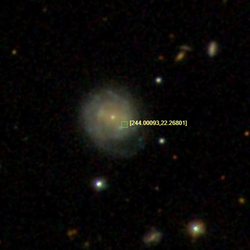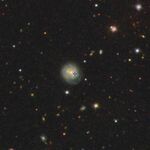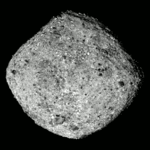Astronomy:AT2018cow
 Location of AT2018cow | |
| Event type | Astronomical explosion |
|---|---|
| Date | 16 June 2018, 10:35:02 UTC[1] |
| Instrument | ATLAS-HKO[1] |
| Constellation | Hercules |
| Right ascension | 16h 16m 00.2242s[2] 16h 16m 00.22s[1] (244.000927647)[3] |
| Declination | +22° 16′ 04.890″[2] +22° 16′ 04.83″[1] (+22.2680094118)[3] |
| Epoch | J2000.0 |
| Distance | 200 Mly (60 Mpc)[1] |
| Redshift | 0.014145,[1] 0.0136[4] (0.01406/parent galaxy)[4] |
| Website | atlas |
Coordinates: ![]() 16h 16m 00.2242 s, +22° 16′ 04.890 ″
AT2018cow (ATLAS name: ATLAS18qqn; also known as Supernova 2018cow, SN 2018cow, and "The Cow") was a very powerful astronomical explosion, 10 – 100 times brighter than a normal supernova, spatially coincident with galaxy CGCG 137-068, approximately 200 million ly (60 million pc) distant in the Hercules constellation. It was first detected on 16 June 2018 by the ATLAS-HKO telescope, and had generated significant interest among astronomers throughout the world. Later, on 10 July 2018, and after AT2018cow had significantly faded, astronomers, based on followup studies with the Nordic Optical Telescope (NOT), formally described AT2018cow as SN 2018cow, a type Ib supernova, showing an "unprecedented spectrum for a supernova of this class"; although others, mostly at first but also more recently, have referred to it as a type Ic-BL supernova. An explanation to help better understand the unique features of AT2018cow has been presented.
16h 16m 00.2242 s, +22° 16′ 04.890 ″
AT2018cow (ATLAS name: ATLAS18qqn; also known as Supernova 2018cow, SN 2018cow, and "The Cow") was a very powerful astronomical explosion, 10 – 100 times brighter than a normal supernova, spatially coincident with galaxy CGCG 137-068, approximately 200 million ly (60 million pc) distant in the Hercules constellation. It was first detected on 16 June 2018 by the ATLAS-HKO telescope, and had generated significant interest among astronomers throughout the world. Later, on 10 July 2018, and after AT2018cow had significantly faded, astronomers, based on followup studies with the Nordic Optical Telescope (NOT), formally described AT2018cow as SN 2018cow, a type Ib supernova, showing an "unprecedented spectrum for a supernova of this class"; although others, mostly at first but also more recently, have referred to it as a type Ic-BL supernova. An explanation to help better understand the unique features of AT2018cow has been presented.
History
AT2018cow (ATLAS name: ATLAS18qqn; also known as Supernova 2018cow, SN 2018cow, and "The Cow"[5]) was first detected on 16 June 2018 at 10:35:02 UTC by the ATLAS-HKO telescope, a twin 0.5 m (20 in) system, at the Haleakala Observatory in Hawaii.[1][6][7] It was a powerful astronomical explosion (discovery magnitude 14.739; redshift 0.014145,[1] 0.0136[4]), 10 – 100 times brighter than a normal supernova,[8][9][10][11] spatially coincident with galaxy CGCG 137-068, approximately 200 million ly (60 million pc) distant in the Hercules constellation.
By 22 June 2018, this transient astronomical event had generated significant interest among astronomers throughout the world.[12] At least 24 major telescopes were observing the event, the largest number, to date, of concurrent observations (over 35 posted on 27 June 2018)[13] of any astronomical event ever reported on The Astronomer's Telegram.[10][14][15] The event had been tentatively identified as a supernova and given the designation Supernova 2018cow and classification SN Ic-BL.[3][16][17][18]
On 25 June 2018, astronomers, using the 2.0 m (79 in) Liverpool Telescope and the 1.5 m (59 in) telescope at Palomar Observatory, noted on The Astronomer's Telegram: "AT2018cow has faded every night since our first observations ([19 June 2018, reference]). ... [Our reported] observations suggest that although a link to Ic-BL SNe and GRBs remains credible given the smooth spectra and luminous radio and X-ray counterpart ([references]), AT2018cow is distinct in other ways and its true identity remains unclear. Observations are continuing."[10][11] On 29 June 2018, astronomers, using 0.6 m (24 in) telescopes at the Beijing Astronomical Observatory,[19] and, on 30 June 2018, using the Swift/XRT telescope,[20] reported further support for the fading of AT2018cow.
On 2 July 2018, astronomers, using the Fermi Large Area Telescope (LAT), reported that there were no significant >100 MeV gamma-ray emissions between 19–26 June 2018.[21] Further, on 3 July 2018, astronomers reported, using the Cadmium Zinc Telluride Imager (CZTI) detector aboard the AstroSat space observatory, no hard X-ray transients were detected between 13–16 June 2018 (event detection time)[22] and, using the UVIT fitted with a F172M filter, observed an AB magnitude of an estimated 17.6 at the AT2018cow location on 3 July 2018.[23] Moreover, astronomers on 3 July 2018 reported, using the MAXI GSC detector aboard the ISS, that no significant X-ray emissions were detected between 11–21 June 2018.[24] On 4 July 2018, astronomers, using NuSTAR, reported a lessening of hard X-ray emissions from AT2018cow.[25] On 12 July 2018, astronomers, using INTEGRAL, reported no detections of the source from 30 June – 8 July 2018; however, GRB-like bursts may have been observed earlier in the vicinity, on 12 and 15 June 2018, although association of these bursts with AT2018cow may be "disfavored".[26]
Radio emissions, at 5 GHz with a flux density of ~ 170 microJy, were detected from the location of AT2018cow on 3–4 July 2018 by e-MERLIN;[27] radio emissions at the AT2018cow location were detected by ATCA at 5.5 GHz with ~0.4 mJy flux density and at 9 GHz with ~1.0 mJy on 3 July 2018, and at 34 GHz with ~10 mJy on 5 July 2018.[28] VLBI observations at 22 GHz, with the NRAO, using the VLBA and Effelsberg radio telescopes, found a total flux density of ~5 mJy around 8 July 2018 at a reportedly more accurate (but consistent within uncertainties) astrometric location of AT2018cow (RA=16h 16m 00.2242s, DEC=22d 16' 04.890") than that of e-MERLIN.[2][27]
On 10 July 2018, astronomers, based on followup studies with the 2.56 m (101 in) Nordic Optical Telescope (NOT), formally described AT2018cow as SN 2018cow and as a type Ib supernova, showing an "unprecedented spectrum for a supernova of this class".[4] On 19 July 2018, astronomers, using the 1.5 m (59 in) Kanata telescope at the Higashi-Hiroshima Observatory, observed further declines in the optical and near-infrared luminosity of the AT2018cow position in early July 2018, and noted that the large decline rates of the light curves were "quite large" compared to Type Ic (Ic-BL) and Type Ib/c supernovae.[29]
On 6 August 2018, ultraviolet observations of the AT2018cow location, using the Wide Field Camera 3 (WFC3) on the Hubble Space Telescope (HST), detected brightness (Vega mag) of about 19 on all four bands (F218W, F225W, F275W, F336W) studied.[30] On 12 August 2018, astronomers at the Giant Metrewave Radio Telescope (GMRT) detected a low frequency radio emission (1390 MHz band; 438+/-82 uJy) at the AT2018cow position.[31]
On 15 August 2018, astronomers using the High Energy Stereoscopic System (H.E.S.S.) array of Cherenkov telescopes (CTA) reported no significant gamma-ray source at the AT2018cow location on 3–5 July 2018, which, as a consequence, resulted in the preliminary determination of upper limits on the integrated flux of the Very-High-Energy (VHE) gamma emission from AT2018cow as follows: above the energy threshold 220 GeV (±2sd) an upper limit of 5e-12 ph cm^-2 s^-1; above 1 TeV (±2sd) an upper limit of 5e-13 ph cm^-2 s^-1.[32]
Properties
According to astronomers at the time of its discovery, the explosion, with a surface temperature of over 8,900 °C (16,000 °F; 9,200 K) and traveling 20,000 km/s (12,000 mi/s),[9] may have been a cataclysmic variable star (CV), gamma-ray burst (GRB), gravitational wave (GW), supernova (SN), or something else.[1][5][10][33][34][14] According to astronomer Kate Maguire of Queen's University Belfast: "It really just appeared out of nowhere. There are other objects that have been discovered that are as fast, but the fastness and the brightness, that's quite unusual."[33]
The classification of type Ic-BL indicates a spectrum with very unusually broad lines, but with no hydrogen lines and weak or missing helium lines. Such a spectrum is produced by the explosion of a very large star which has lost its outer layers of hydrogen and helium.[35] However, according to astronomer Shubham Srivastav, associated with the 2.0 m (79 in) Himalayan Chandra Telescope (HCT): "Although spectroscopic features indicate a tentative similarity with broad line Ic supernovae, its true nature remains a puzzle."[35] Also, according to Maguire: "We're not sure yet what it is, but the normal powering mechanism for a supernova is radioactive decay of nickel, and this event is too bright and too fast for that."[33] The AT2018cow explosion could have been accompanied by a GW emission, but the GW emission could not be detected since the LIGO detectors in the states of Washington (state) and Louisiana were down at the time of the event due to service upgradings.[10]
An explanation to help better understand the unique features of AT2018cow, particularly as a white dwarf tidal disruption event, has been presented.[36]
As of 29 September 2018, AT2018cow has been explained in various ways, including as a type Ic supernova, a gamma-ray burst, an interaction between a white dwarf and black hole, and as a magnetar. Preliminary studies to better understand the exact physical nature of AT2018cow, using the European VLBI Network (EVN), have been presented.[37]
See also
- Superluminous supernova, a supernova at least ten times more luminous than a standard supernova
References
- ↑ 1.0 1.1 1.2 1.3 1.4 1.5 1.6 1.7 1.8 Smartt, S. J. et al. (17 June 2018). "ATLAS18qqn (AT2018cow) - a bright transient spatially coincident with CGCG 137-068 (60 Mpc)". The Astronomer's Telegram (11727). http://www.astronomerstelegram.org/?read=11727. Retrieved 22 June 2018.
- ↑ 2.0 2.1 2.2 Bietenholz, M. et al. (31 July 2018). "VLBI Detection and Astrometry for AT2018cow". The Astronomer's Telegram (11900). http://www.astronomerstelegram.org/?read=11900. Retrieved 1 August 2018.
- ↑ 3.0 3.1 3.2 "SN 2018cow". Transient Name Server. International Astronomical Union. 22 June 2018. https://wis-tns.weizmann.ac.il/object/2018cow. Retrieved 23 June 2018.
- ↑ 4.0 4.1 4.2 4.3 Benetti S. et al (10 July 2018). "NUTS update on the spectroscopic follow-up of SN 2018cow". The Astronomer's Telegram. http://www.astronomerstelegram.org/?read=11836. Retrieved 10 July 2018.
- ↑ 5.0 5.1 Crane, Leah (21 June 2018). "We've just seen a huge space explosion and don't know what it is". New Scientist. https://www.newscientist.com/article/2172351-weve-just-seen-a-huge-space-explosion-and-dont-know-what-it-is/. Retrieved 22 June 2018.
- ↑ Mandke, Mandar et al. (21 July 2018). "AT 2018 COW- the mysterious Supernova". NatSkies.com. http://www.natskies.com/2018/07/21/at-2018-cow-the-mysterious-supernova/. Retrieved 4 September 2018.
- ↑ Prentice, S. J.; Maguire, K.; Smartt, S. J.; Magee, M. R.; Schady, P.; Sim, S.; Chen, T. -W.; Clark, P. et al. (2018). "The Cow: Discovery of a luminous, hot and rapidly evolving transient". The Astrophysical Journal 865: L3. doi:10.3847/2041-8213/aadd90.
- ↑ Anderson, Paul Scott (28 June 2018). "Astronomers see mystery explosion 200 million light-years away - Supernovae, or exploding stars, are relatively common. But now astronomers have observed a baffling new type of cosmic explosion, believed to be some 10 to 100 times brighter than an ordinary supernova.". Earth & Sky. http://earthsky.org/space/mystery-explosion-at2018cow-nicknamed-the-cow. Retrieved 28 June 2018.
- ↑ 9.0 9.1 Staff (26 June 2018). "Scientists Confused: A Huge Explosion Has Been Observed In Space". Tech2.org. https://tech2.org/lithuania/scientists-confused-a-huge-explosion-has-been-observed-in-space/. Retrieved 26 June 2018.
- ↑ 10.0 10.1 10.2 10.3 10.4 Kaplan, Sarah (25 June 2018). "'I've never seen anything like this': Astronomers dazzled by brilliant supernova". The Washington Post. https://www.washingtonpost.com/news/speaking-of-science/wp/2018/06/25/ive-never-seen-anything-like-this-astronomers-dazzled-by-brilliant-supernova/. Retrieved 25 June 2018.
- ↑ 11.0 11.1 Perley, D. A. et al. (25 June 2018). "AT2018cow: Continued optical fading and weakening of spectral features". The Astronomer's Telegram (11776). http://www.astronomerstelegram.org/?read=11776. Retrieved 25 June 2018.
- ↑ "Telegram Index". The Astronomer's Telegram. 22 June 2018. Archived from the original on 22 June 2018. https://web.archive.org/web/20180622224952/http://astronomerstelegram.org/. Retrieved 22 June 2018.
- ↑ "Telegram Index". The Astronomer's Telegram. 27 June 2018. Archived from the original on 27 June 2018. https://web.archive.org/web/20180627163305/http://www.astronomerstelegram.org/. Retrieved 27 June 2018.
- ↑ 14.0 14.1 Petit, Harry (22 June 2018). "Mystery of the massive explosion 200 million light years away: Strange flash 100 times brighter than a supernova that is growing at an incredible rate baffles scientists". Daily Mail. http://www.dailymail.co.uk/sciencetech/article-5874659/Mystery-massive-explosion-200-light-years-away.html. Retrieved 23 June 2018.
- ↑ Kennedy, Sequoyah (24 June 2018). "Massive Explosion of Unknown Origin Rips Through Neighboring Galaxy at 'Incredible Speed'". Mysterious Universe. http://mysteriousuniverse.org/2018/06/massive-explosion-of-unknown-origin-rips-through-neighboring-galaxy-at-incredible-speed/. Retrieved 25 June 2018.
- ↑ Bishop, David (22 June 2018). "Latest SuperNovae". Astronomy Section, Rochester Academy of Sciences. http://www.rochesterastronomy.org/supernova.html#2018cow. Retrieved 22 June 2018.
- ↑ Bishop, David (22 June 2018). "Supernovae 2018cow in CGCG 137-068". Astronomy Section, Rochester Academy of Sciences. http://www.rochesterastronomy.org/sn2018/sn2018cow.html. Retrieved 22 June 2018.
- ↑ "The Calculated Sky - AT2018cow". Calsky.com. Archived from the original on 25 June 2018. https://archive.today/20180625130322/https://www.calsky.com/observer/csrender.cgi?number=11&tdt=2458295.65490048&ra=16h16m00.220s&de=+22d16m04.83s&fovarcmin=15&coorEphem=TopoEquAstro2000.
- ↑ Li, H. et al. (29 June 2018). "SVOM/GWAC-F60 and GRANDMA optical follow-up of AT2018cow/ATLAS18qqn". The Astronomer's Telegram (11796). http://www.astronomerstelegram.org/?read=11796. Retrieved 30 June 2018.
- ↑ Sandoval, L.E. Rivera; Maccarone, T. (30 June 2018). "Increase in the X-ray flux of AT2018cow". The Astronomer's Telegram (11801). http://www.astronomerstelegram.org/?read=11801. Retrieved 30 June 2018.
- ↑ Kocevski, D.; Cheung, C.C. (2 July 2018). "Fermi-LAT Search for Gamma-ray Emission from AT2018cow". The Astronomer's Telegram (11808). http://www.astronomerstelegram.org/?read=11808. Retrieved 2 July 2018.
- ↑ Sharma, Y. et al. (3 July 2018). "AT2018cow - AstroSat CZTI limits on prompt emission". The Astronomer's Telegram (11809). http://www.astronomerstelegram.org/?read=11809. Retrieved 3 July 2018.
- ↑ Singh, Avinash; Bhalerao, Varun; Mondal, Chayan; Sahu, Snehalata (6 July 2018). "AstroSat UVIT Observations of AT2018cow". The Astronomer's Telegram (11822). http://www.astronomerstelegram.org/?read=11822. Retrieved 6 July 2018.
- ↑ Sugizaki, M. et al. (3 July 2018). "AT2018cow: MAXI GSC data search". The Astronomer's Telegram (11810). http://www.astronomerstelegram.org/?read=11810. Retrieved 3 July 2018.
- ↑ Grefenstette, B. et al. (4 July 2018). "Evidence for fading of the hard X-ray emission from AT2018cow". The Astronomer's Telegram (11813). http://www.astronomerstelegram.org/?read=11813. Retrieved 4 July 2018.
- ↑ Savchenko, V. (12 July 2018). "INTEGRAL observations of decaying hard X-ray emission from AT2018cow". The Astronomer's Telegram (11843). http://www.astronomerstelegram.org/?read=11843. Retrieved 12 July 2018.
- ↑ 27.0 27.1 Horesh, A. et al. (5 July 2018). "e-MERLIN 5 GHz Observations of AT2018cow". The Astronomer's Telegram (11819). http://www.astronomerstelegram.org/?read=11819. Retrieved 5 July 2018.
- ↑ Dobie, Dougal et al. (17 July 2018). "AT2018cow: Continued ATCA monitoring". The Astronomer's Telegram (11862). http://www.astronomerstelegram.org/?read=11862. Retrieved 17 July 2018.
- ↑ Yamanaka, M. et al. (19 July 2018). "Kanata Optical and Near-infrared Observations of AT 2018cow". The Astronomer's Telegram (11868). http://www.astronomerstelegram.org/?read=11868. Retrieved 19 July 2018.
- ↑ Kilpatrick, C.D. et al. (6 August 2018). "HST/WFC3 Ultraviolet Observations of AT2018cow". The Astronomer's Telegram (11921). http://www.astronomerstelegram.org/?read=11921. Retrieved 6 August 2018.
- ↑ Nayana, A.J.; Chandra, Poonam (14 August 2018). "Low frequency detection of AT2018cow with the GMRT". The Astronomer's Telegram (11950). http://www.astronomerstelegram.org/?read=11950. Retrieved 14 August 2018.
- ↑ de Naurois, Mathieu (15 August 2018). "H.E.S.S. upper limits on VHE gamma emission from AT2018cow". The Astronomer's Telegram (11956). http://www.astronomerstelegram.org/?read=11956. Retrieved 15 August 2018.
- ↑ 33.0 33.1 33.2 Moore, Kristine (22 June 2018). "An Explosion Has Rocked Space 200 Million Light Years From Earth And Scientists Are Unsure What Is Causing It". Inquisitr. https://www.inquisitr.com/4954089/an-explosion-has-rocked-space-200-million-light-years-from-earth-and-scientists-are-unsure-what-is-causing-it/. Retrieved 25 June 2018.
- ↑ "Mystery of the massive explosion 200 light years away". Mogaznews. 22 June 2018. https://en.mogaznews.com/Technology/943442/Mystery-of-the-massive-explosion-200-light-years-away.html. Retrieved 23 June 2018.
- ↑ 35.0 35.1 Desikan, Shubashree (1 July 2018). "Astronomers puzzled by ‘cow’ in the sky". The Hindu. https://www.thehindu.com/sci-tech/science/astronomers-puzzled-by-cow-in-the-sky/article24300319.ece. Retrieved 1 July 2018.
- ↑ Kuin, N. Paul M. et al. (26 August 2018). "Swift spectra of AT2018cow: A White Dwarf Tidal Disruption Event?". arxiv. https://arxiv.org/abs/1808.08492. Retrieved 19 October 2018.
- ↑ An, Tao (29 September 2018). "The EVN detection of AT2018cow at 1.67GHz". The Astronomer's Telegram (12068). http://www.astronomerstelegram.org/?read=12067. Retrieved 29 September 2018.
External links
- AT2018cow webpage on the Transient Name Server
- AT2018cow webpage at Vanbuitenen.nl
- AT2018cow webpage by the Astronomy Section Rochester Academy of Science
- CGCG 137-068 webpage at the NASA/IPAC Extragalactic Database
- AT2018cow images from 21 June 2018 by Cedric Raguenaud




